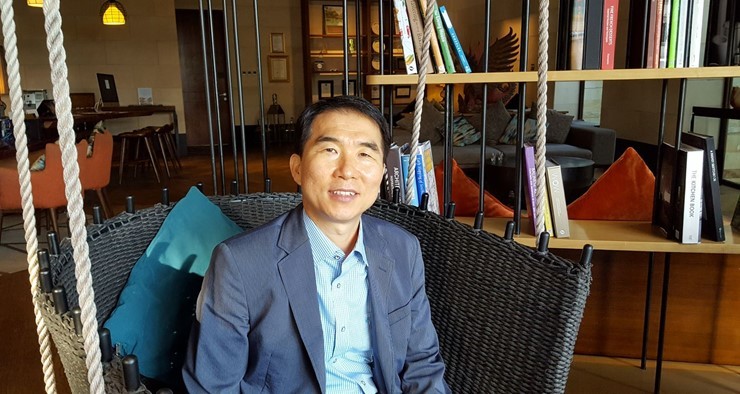BOK Deputy Governor: the balance sheets of central banks are likely to expand continuously for the time being
nyomtatásEurasia notes
BOK Deputy Governor: the balance sheets of central banks are likely to expand continuously for the time being
10 March 2021
By Harsányi Péter, 9 November 2020. Published at Növekedés.hu:
https://novekedes.hu/english/bok-deputy-governor-the-balance-sheets-of-central-banks-are-likely-to-expand-continuously-for-the-time-being
The Deputy Governor of the Bank of Korea told novekedes.hu that most countries in the Asian region are expected to be less severely hit than the US or the Euro area. According to Kyuil Chung, the Korean New Deal with other relevant measures ensure that the great transformation toward a digital and green economy will lead to sustainable and inclusive growth.
The sluggishness of the Korean economy started easing as we entered the second half of this year (GDP growth rate: 19.4Q 1.3%› 20.1Q –1.3% › 2Q –3.2% › 3Q 1.9%). After having resurged in mid-August, the COVID-19 pandemic has been somewhat contained since the end of September, thus social distancing measures have also been eased. Private consumption still remains weak due to the resurgence of new COVID-19 cases between August and September.
However, the decline in exports is significantly slowdown with the steady recovery of the Chinese economy coupled with the resumption of economic activity in major economies since May, such as the US and the Euro area.

The Korean economy is expected to recover gradually, driven mainly by exports, albeit with a very high uncertainty surrounding its growth path.
Given that the economic recovery in Korea is bound to be highly dependent on COVID-19 developments, it is crucial to ensure strict disease control in terms not only of public healthcare but also of the economy.
While most countries in the Asian region are expected to be less severely hit than the US or the Euro area, the pace of economic recovery is likely to remain limited due to the continued spread of the virus.
The Chinese economy is picking up relatively quickly as production growth accelerates and investment in infrastructure and real estate increases, whereas other EMEs across the region, including India, continue to go through a slump due to the coronavirus pandemic.
What kind of monetary and fiscal policy measures are used in South Korea to support the economic recovery?
The Bank of Korea has aggressively strengthened its accommodative monetary policy stance to respond to financial market strains and growing downside risks to the macroeconomy following the spread of the pandemic. The Bank of Korea cut the Base Rate by 50 basis points at an unscheduled meeting in March, and by a further 25 basis points in May. The Base Rate now stands at the historically-low level of 0.5%.
The Bank has also expanded the use of policy tools other than the Base Rate, such as loans and liquidity provision.
In order to help self-employed businesses and SMEs troubled by the pandemic, the Bank of Korea raised the total ceiling of the Bank Intermediated Lending Support Facility by USD $15.6 billion.
The Bank of Korea also launched a new Corporate Bond-Backed Lending Facility as a new standing facility that allows ready access to credit for financial institutions with high-quality corporate bonds as collateral.
The Bank of Korea also adopted a full-allotment RP purchase facility to maintain sufficient liquidity by making uncapped RP purchases, through which it has provided USD $16.9 billion. The Bank also purchased treasury bonds amounting to USD $8.3 billion this year.
In the meantime, the government, state-owned banks, and the Bank of Korea established an SPV to support the credit market by purchasing corporate bonds and CPs. The Bank will provide total liquidity of USD $7 billion to this facility.
The government has been maintaining an expansionary fiscal policy to tackle the pandemic, as well. The government earmarked a total volume of USD $58 billion through four rounds of supplementary budgets. These funds have been used to implement various COVID-19 responses, such as disaster relief payments, lending assistance, loan deferment, and increased joint investments.

What are the key elements of the New Deal Program of South Korea?
The Korean New Deal is a national development strategy for Korea to overcome the current crisis and become a leader in the post-COVID-19 global economy.
To achieve these goals, the government will push ahead with the two pillars of the new initiative, the Digital New Deal and the Green New Deal, while bolstering social safety nets as a backstop.
The Digital New Deal will promote a dynamic economy by providing opportunities to create new businesses. In order to accelerate the transition towards a digital economy, the government will establish digital infrastructure nationwide, which will be used for the provision of non-face-to-face medical treatment, a learning environment that incorporates a blend of both online and offline methods, and simulation-based land and facilities management.
The Green New Deal aims to further increase investment in and support for the environmental and energy sectors in order to implement the greenhouse gas reduction plan on schedule and move towards a net-zero society.
The Green New Deal will help facilitate investment in solar and wind power plants, expand the supply of electric and hydrogen vehicles, and increase demand for eco-friendly vessels, all of which are expected to offset shocks from carbon leakage and the border carbon adjustment to some extent.
Lastly, the government plans to improve employment and social safety nets such as employment insurance and the national basic livelihood security program, in order to protect the vulnerable from employment shocks and eliminate blind spots. It will also nurture future-oriented talent in preparation for changes in the coming job market and expand investment in human resources to reduce digitally vulnerable groups. All these ensure that the great transformation toward a digital and green economy will lead to sustainable and inclusive growth.
The South Korean economy has experienced a very impressive development over the past century. In your opinion, what can Hungary learn from this process?
Since the 1960s, the Korean economy has actively responded to changing conditions at home and abroad and achieved high economic growth led by the export-oriented manufacturing sector.
It is generally understood that a combination of proactive industrial policies focusing on exports and the manufacturing industry as well as high savings and investment rates served as the key drivers for long-term high growth, especially in its early stages.
Since the 2000s, Korea has successfully transformed itself from a manufacturing-oriented to an IT-oriented economy.
The share of the IT industry in Korea’s economy increased from 2.1% in 1995 to 10.8% in 2019.
Companies expanded their global market share by boosting competitiveness through continuous R&D investment and marketing. Large corporations in particular led the development of the semiconductor and display panel industries that require large-scale facilities investments.
The government, for its part, recognized the waves of IT revolution as a new challenge, as well as an opportunity, and thus focused national capacities on facilitating digitization and establishing high-speed internet infrastructure.
As a result, high-tech goods, such as semiconductors, cell phones, and LCD display panels, have positioned themselves as the main export items and the industrial structure has also shifted to technology-intensive high value-added industries.
I think at the core of our economic success lie: the entrepreneurship that drove the advance into global markets without sitting on their laurels; the government that was active in building infrastructure that could encourage entrepreneurship; and, the people’s enthusiasm for education. As a small open economy driven by exports and the manufacturing industry, I think the Hungarian economy is similar to the Korean economy. I hope that Korea’s experience with economic growth will be a useful reference to Hungary.
As a result of monetary policy responses to the coronavirus, the balance sheet of major central banks has increased significantly. Do you believe that central banks will be able to reduce their balance sheets in the long run or they will follow the Japanese way?
We understand that the balance sheet adjustments of the major central banks will depend on developments related to COVID-19, on the pace of economic recovery, and on monetary and fiscal policy operations in major economies.
However, since it won’t be easy for central banks to consider exit strategies for a considerable period of time going forward either, their balance sheets are likely to expand continuously for the time being.
Therefore, we need to pay close attention to this issue so as not to increase worries about central bank independence and monetary policy reliability.
Can the focus of monetary policy be expanded in the future? What other areas could a modern central bank support?
In an environment where low growth and low inflation have been sustained since the global financial crisis, the real economy has been affected by unprecedented shocks from the COVID-19 pandemic. Therefore, calls for a greater role of monetary policy, which has put a focus on price stability so far, will grow further.
The US Fed has already reformed its monetary policy framework with the introduction of AIT and some other central banks have added employment stability to central bank mandates, which could spread to other central banks, as well.
In the wake of COVID-19 in particular, the argument for more active central bank execution of quasi-fiscal activities could increase.
On the other hand, however, awareness is being raised that central banks need to be careful concerning their financial stability mandate, as the gap between the financial and real sectors has widened with greatly accommodative monetary policies.
It is hard to say for sure how much further the mandate and the role of monetary policy should be expanded given the current rapidly changing economic environment. And after all, that will all depend on each country’s policy conditions. Each country should take into overall consideration its own financial and economic conditions, social and institutional conditions, and public consensus on the central bank’s roles.